Rodin and His Practiciens
Or Auguste Didn't Do Exactly What You Think He Did
(With a Modest Proposal for Solving a Century Old Brouhaha)
Or Auguste Didn't Do Exactly What You Think He Did
(With a Modest Proposal for Solving a Century Old Brouhaha)
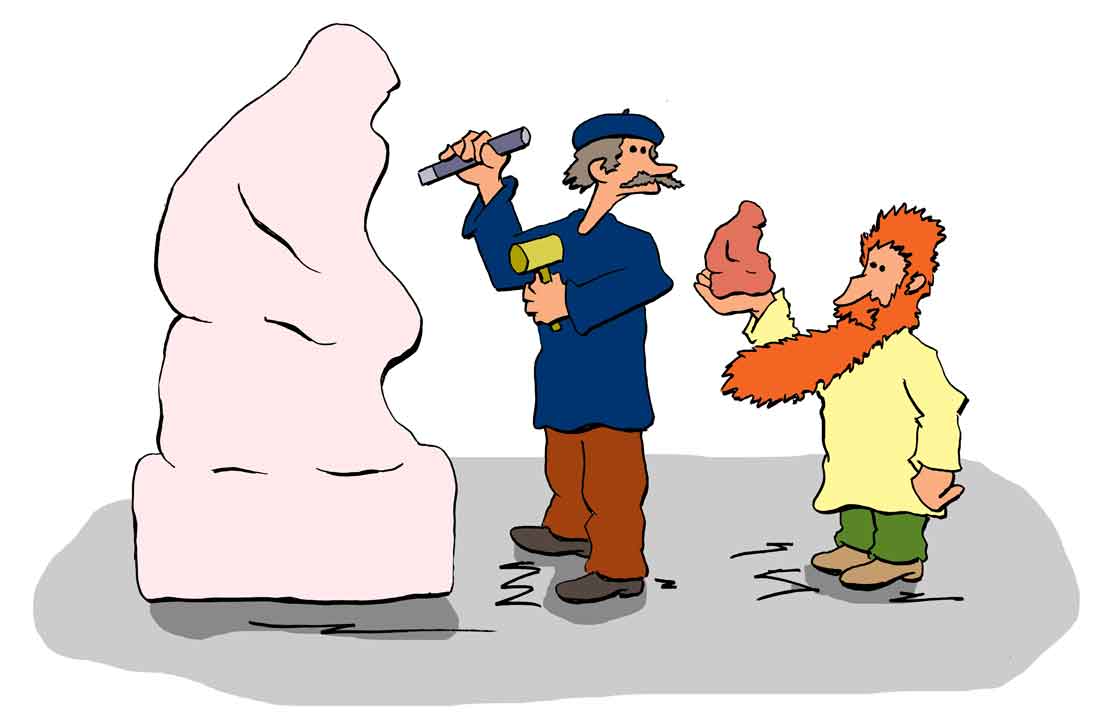
Auguste and his Practicien
If there was one sculptor of the late 19th century who stands above all others - even though he was only about 5' 4" - it is without doubt Auguste Rodin. True, you might find some curmudgeons who don't like his work - it's blocky, clumsy, crude, they say. But today the consensus is - and was even during his own lifetime - that Rodin was the best sculptor of the era.
Of course, some people don't like sculpture at all - or sculptors. Consider these comments from Leonardo da Vinci.
"The sculptor in creating his work does so by the strength of his arm by which he consumes the marble. This is done by a most mechanical exercise, often accompanied by great sweat which mixes with the marble dust and forms a kind of mud daubed over his face. The marble dust flours him all over so that he looks like a baker. His back is covered with a snowstorm of chips, and his house is made filthy by the flakes and dust of stone.
But the painter sits before his work, perfectly at his ease and magnificently clothed, and moves a very light brush dipped in delicate color, and he adorns himself with whatever clothes he pleases. His house is clean and filled with charming pictures, and often he is accompanied by music or by the reading of various and beautiful works which, since they are not mixed with the sound of the hammer or other noises, are heard with the greatest pleasure."
Of course, Leonardo was just making a deliberate jibe at that young whippersnapper, Michelangelo, whom he didn't like. Today many stone sculptors will work stone, not as a "mechanical exercise", but in a creative manner, making decisions as they work. In fact, stone sculptors say that the relatively slow pace of stone carving allows the artist more time for reflection than other media.
On the other hand, before the mid-20th century, many sculptors did use highly mechanical processes to produce the finished work. Some even used pointing machines which were devices that measured exactly how much stone to carve away. But using a pointing a machine - even though it may be a "mechanical exercise" - isn't easy, and you have to know what you're doing.
As for Rodin, he didn't involve himself in any (ptui) mechanical exercise. He certainly didn't have to worry about covering himself like a baker, daubed with a kind of mud, with the chips covering his back. We know that when you stand in awe before one of his bronze or marble sculptures, what you are seeing was not made by Rodin.
What????!!!!!! Rodin didn't make his own sculptures?
No. Rodin didn't make his own sculptures.
What????!!!!!! Not even the marbles?
Nope. Not even the marbles.
Well, all right, Mr. Smarty Pants, if Rodin didn't carve his own statues, then who did?
Hired contract workers.
Who was that again? Who did you say made Rodin's sculptures?
Hired contract workers.
But I saw a film that was made in 1915. It showed Auguste wielding a hammer and chisel. What was that? Some staged phony photo op?
Yep. That's exactly what it was.
But I went to one of the Rodin Museums (either in Paris or in Philadelphia) and I saw a plaster model made when Auguste was only 50. Surely Auguste made that.
Sorry. Not even the plaster models. Even those were made by hired workers.
We repeat, Rodin never made his own statues?
What, never?
No, never.
What never?
Well, as the Captain of the Pinafore said, ...
Je Suis un Artiste ...
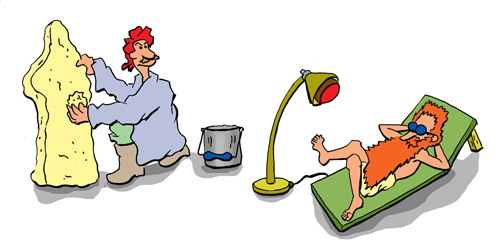
Auguste didn't even make the plaster models.
First of all, to forestall the spittle flinging diatribes that are being hammered out on the keyboard, let us hasten say the present author is a great admirer of Rodin. So this is not a trash-the-great-man article of revisionist history. No. Rodin was indeed the greatest sculptor of the 19th and early 20th century.
Nor was Auguste practicing any deception. When he was alive, everyone who bought an original Rodin knew up front that the bronzes and marbles they were paying good money for were not actually fashioned by Auguste's own hand. That we express surprise (or indignant disbelief) is due to our own modern-day ignorance of the highly collaborative artistic practices which went into making a sculpture in Auguste's day and to a large extent today. And we surely can't blame Auguste for what we don't know.
And we are not saying that Auguste did not create any statues with his own hands. He did indeed. But in general these were not the ones he sold.
You see, Auguste's true expertise was as a clay sculptor - a modeler. His job, he felt, was making of the clay design or the prototype. After all, that's what he learned to do in school.
That François-Auguste-René Rodin would become one of the most famous sculptors in the world was something no one expected. When he was about seventeen he enrolled at Paris's École Impériale Spéciale de Dessin et de Mathématiques (called informally the Petite École as contrasted to the Grand École, the nickname for the prestigious École des Beaux Artes). The Petite École was a tuition-free state sponsored school intended for the lower income students who couldn't get into the fancy schools.
But don't be mislead. The Petite École produced some excellent artists. Some - not only Rodin - became rich and famous, and from time to time the professors of the Beaux Artes would stop by the Petite École to scout out talent for their own school. Auguste, though, never studied at the Beaux Artes.
Auguste's parents had no problem that their son wanted to study art. In that day and age, art was practical, and if you were good, you could make a living at it. Sculptors not only made the statues that peppered the landscapes and buildings, but also created household figurines and decorative ceramics. In fact, it was as a decorative artist that Auguste got his start. Even after he was beginning to make his name as a sculptor, he continued to work for a while in commercial art for its reliable, if not munificent, income.
At the Petite, Auguste's ability was rated as OK, but not particularly extraordinary. The teachers did note, though, that when Auguste made his drawings, he would put in the principle features of the model and then add details from his own imagination. It soon dawned on them that Auguste was near-sighted. So the kid began to wear glasses.
Although Auguste continued to draw all his life (and some of the drawings are, well, rather daring), Auguste preferred sculpture and this meant clay modeling. Today, of course, you can take art classes in carving in stone and wood, metalworking (including welding), and some schools even have foundry classes where you learn to cast your own bronzes. But clay modeling is what you take to learn the principles of sculpture.
Why? Well, bronze and stone are neither cheap nor what they call "forgiving" media. For fiddling around, you use clay. It's cheap, easy to work with, and the consistency can be altered to suit the the task. You can change your mind at any point. Clay will dry in air and even at that point, if you don't like it, you can re-wet it and rework the difficult parts. Then if you still don't like it, you can toss the whole statue into a tub of water and recycle the clay.
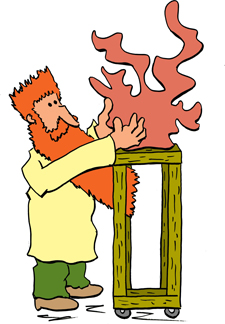
Clay is perfect for fiddling around.
Finally, a clay statue can be fired in a kiln. Fired clay - terracotta - is not just clay with all the water driven off. The chemical structure of the mineral actually alters, and the statue becomes waterproof and hard as stone. It can last literally forever. Then you can add glazes and patinas of various types, some of which will even make your statue look like a stone carving or a metal sculpture.
And, yes, if you see a terracotta "Rodin", then you may very well be seeing something fashioned by the maestro himself. These are called "autograph" sculptures. But Rodin's clay sculptures are not that common. In one collection with hundreds of Rodin sculptures (the Iris and B. Gerald Cantor Arts Center at Stanford University), there are three - count 'em - three terra cotta sculptures by Rodin. One of these is a portrait of an early employer and mentor Albert-Ernest Carrier-Belleuse. So with a terracotta we never have to worry that we're not seeing something that Auguste created himself.
What never?
No, never.
What never?
Well ...
... Pas un (puti) Practicien!
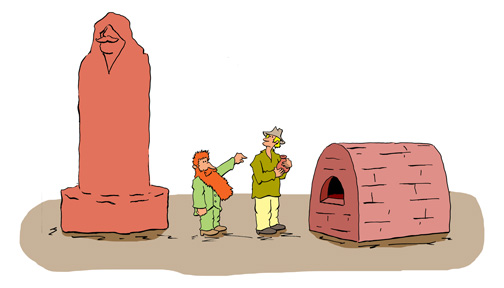
Not convenient
So the first thing Auguste would do to make a "Rodin" was to make a clay model. There's no doubt about his skill but exactly how he worked depends on who told the story. Once Rodin was returning home from a fancy souirée and was still in a frock coat and top hat. He stopped by the studio of the sculptor Jules Desbois and was describing a small statue he was working on which he thought Jules could make into a larger version. To show Jules what he was talking about Rodin, coat over arm and hat on head, suddenly grabbed some clay and fashioned a statue in about half an hour.
But Henri Rochefort, the French writer and politician who had supported the French Commune (a turbulent time which Auguste negotiated by bugging out to Belgium), left us a bit of a different story. When he was sitting for a portrait, he said Auguste would look at him for an hour. Next Auguste would take a little "bullet" of clay and plop it on the bust. Then he would look at Henri for another hour and take the bullet off. This went on for months. For his part Auguste complained that Henry couldn't sit still.
So it seems that Auguste could work rapidly if he wanted to, particularly on clay maquettes or sketches. But he preferred to take his time and experiment around. So some of the statues, which to our eyes do look rough and fairly simple (like the portrait of Henri's), could take him months or even years finish.
Naturally, this deliberate style of working sometimes got Auguste into hot water. Once a newspaperman published a spittle-flinging diatribe about how M. Rodin had been paid good money by the government for a number of tax-payer sponsored commissions and yet years later nothing had been finished. One statue with an eighteen month deadline wasn't completed for seven years! But in his early days as a decorative artist, Auguste had deadlines which he had to keep to.
Now sometimes when Auguste had finished a clay model he might take it to a potter's or ceramist's kiln and have it fired. Unfired clay, after all, is far from permanent, and the air-dried particles are simply held together by adhesion. Although the surface can dry to what seems to be pretty hard, the piece can be easily broken. It can reabsorb water and is susceptible to freeze/thaw damage. Some of Auguste's clay sculptures just sat around until they crumbled.
But firing his model to terracotta is not what Auguste would usually do. Instead, at this point he would turn the model over to a skilled technician - the practicien. In the context of Rodin and his art, when people talk about a practicien, they usually mean a skilled marble carver. However, we can use the word to mean all the skilled artists that practiced a specialty.
Instead, most of the time Auguste's permanent (more or less) sculptures were made of plaster. Making plaster sculptures was SOP for sculptors in Auguste's time, and it remains common for a lot of sculptors even today. Plaster is cheaper than marble or bronze, and can be repaired without much trouble. Plaster models are what Auguste usually submitted to the national art exhibition, the famous Paris Salon, and plasters are also what he gave his friends as gifts.
But why make a plaster model? Why not just take the sculpture down to his friendly neighborhood pottery kiln? After all, terracotta sculpture was popular in certain regions where marble wasn't common. And at least we'd have a Rodin fashioned by his own hand?
Well, again it's convenience and cost. Terracotta is OK if your statue is about the size of a bowl or vase. But suppose you have a life-sized statue. Or something even larger like Auguste's monument to Balzac? You might be looking for a kiln for quite a while.
But making a plaster model is something you can do at home, and it's cheap. A bag of plaster, water, and a place where you can make a mess will do fine.
Now you can make a plaster sculpture by molding and carving. But a plaster statue is usually a cast made from a mold which in turn is fashioned from the clay original. In Auguste's day, the simplest procedure was to use what sculptors call a waste mold.
As the name implies the waste mold is a temporary mold that is lost - that is, "wasted" - during the process. They are often fashioned in two parts, although for large or complex sculptures you may need more sections. And the waste molds themselves are made of plaster.
What? You make a mold of plaster to cast a plaster statue?
Yep. That's exactly what you do.
One advantage of a making a waste mold is that you don't need to let the clay dry completely. Instead, the model just needs to be firm and hold its shape when handled. This state is reached in a few days and because the surface feels a bit like stiff leather, it is so dubbed. Even a beginner quickly learns to recognize a "leather" statue, and you can see an example of sculpture at it's leather stage if you click here.)
Without going into great details, the waste mold is made by first coating the statue with a release agent so the plaster won't stick to it. Today spray-on silicone release agents are preferred for almost all applications. But in Auguste's time, they used the old stand-bys like petroleum jelly or vegetable oils. Another popular release agent was "green soap", a soft soap made from vegetable oils and potash and which remains part of the arsenal of tattoo artists.
Once you have the statue slicked up, then you add the plaster to the surface with shims placed on the statue defining the different sections. The first layer of plaster is thin and some sculptors actually flick the plaster at the sculpture to reach all those hard to reach places. An experienced plaster sculptor can do this without getting bespattered, although students tend to get the stuff all over themselves and the studio. Usually a waste mold has three layers of plaster.
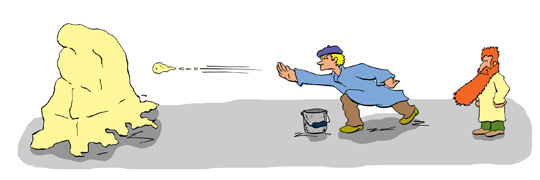
You flick the plaster at the sculpture.
Obviously we've left out a number of the details, but in the end you have your clay model covered in plaster. But once it hardens you can then carefully separate the sections. Now if the statue was made of something other than clay you would find it would be locked into the mold due to over hanging edges - "undercuts" as they're called. But now you'll find the clay - even if it was completely dry - has absorbed water from the plaster and is now as soft as when you began modeling. So you just pull the clay out bit by bit and either throw it away or recycle it (probably throw it out as clay isn't very good with bits of plaster mixed in). Then you rinse out the inner part of the mold - again taking care to avoid damaging the detail. Voila! You have your "waste mold".
Here is where you get your "real" sculpture. You again add a release agent to the inside the mold and put it back together. You can keep everything in place with string or ropes and then seal the two parts along the parting lines with more plaster.
Finally you pour fresh liquid plaster into the mold and let it set. Setting should be anytime from a couple of hours to a day.
But hold on! You earlier said a rigid statue would lock itself into the mold due to the undercuts. And we've just made a rigid statue! So what do we do now? Rend our garments or beat our breasts?
Well, admittedly we are at the touchy part. You take a hammer and chisel and carefully chip away the mold. Yes, you're chipping away plaster from plaster. And if you forgot to put on a release agent, you've pretty much blown your statue.
There is a bit of a technique to wielding the chisel when removing a waste mold. You slant it at an angle so it doesn't actually hit the surface of the statue. Then if all goes well the mold will chip cleanly away from the surface of the cast. This leaves you with the final plaster cast with all the detail of the original clay sculpture.
Although today many sculptors make their own plaster models, Rodin did not. We know this because at one point he wrote he couldn't submit a sculpture to a show because he couldn't afford to have the plaster model made. Now he certainly knew the principles of mold making, and he may have made some molds when working as a decorative artist. But if you have a sculpture going to the Salon, you want professional work.
The best of the plaster specialists who worked with Rodin were a father and son team, Diedonné and Eugene Guioché, and they worked with an assistant whom we just know as Barbier. They had a special formula for plaster where they added finely chopped straw and beat it into the liquid "like a housewife whipping egg whites". They also made the plaster models in separate parts rather than as a single (and solid) case, and then they fitted the pieces together.
The advantage of the Guiochés' method was the final plaster statue could be hollow and have particularly thin walls. The pieces were joined together by placing strips of tape soaked in the plaster on the inside. Naturally this procedure took quite a bit longer than making the cast in one piece. But the trouble was worth it, and the final sculptures produced by the Guiochés were strong and surprisingly light. One of their casts of the enlarged version of the "Thinker" was so light it could be picked up and easily carried by one person.
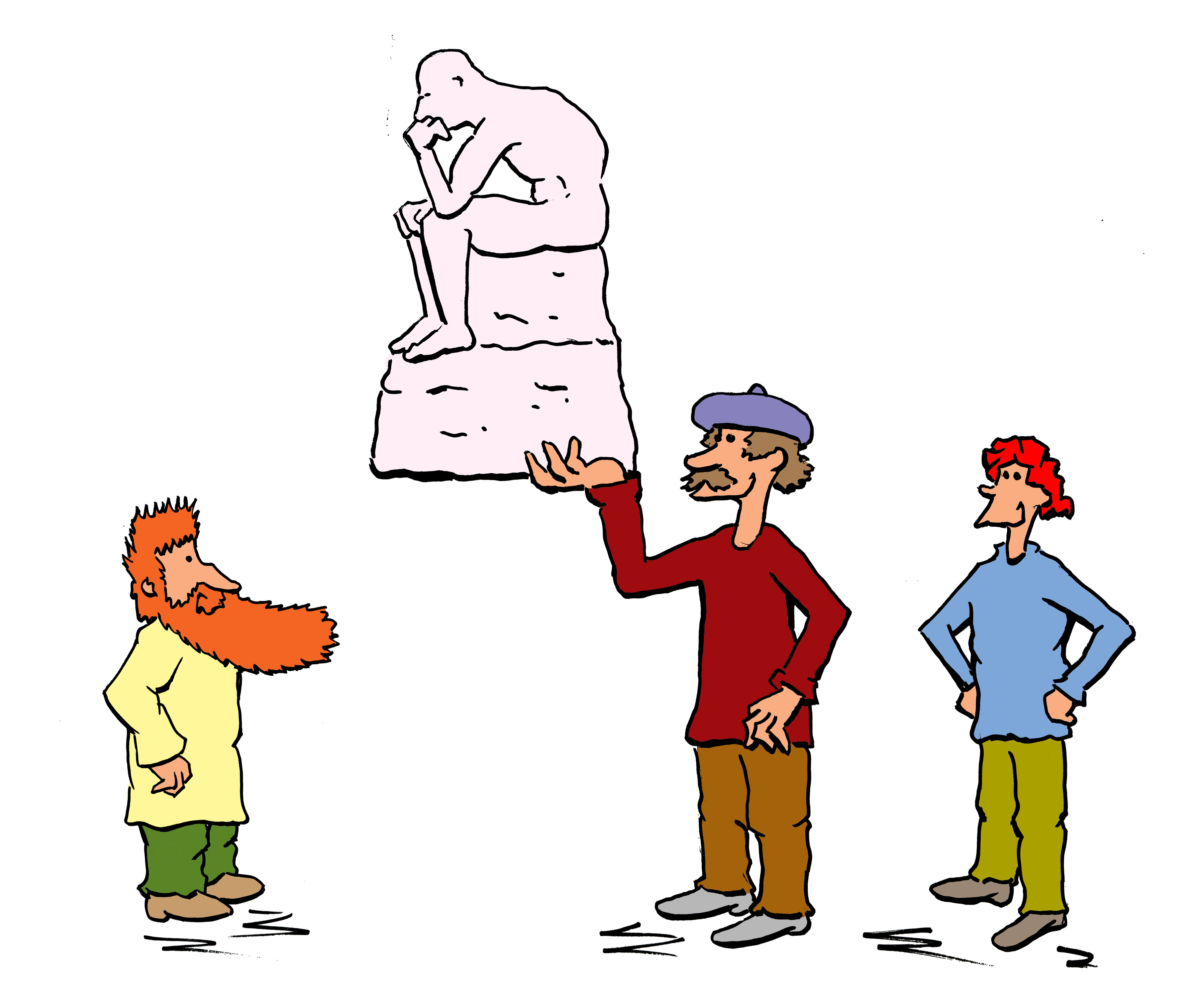
La Methode Guiochés
But why Auguste really liked the Guiochés is they had a technique for making plaster copies of finished statues. Obviously you can't make a waste mold if you have a statue made of marble. Besides marble, being porous, absorbs plaster and that lustrous luminous and translucent surface now looks like plaster. So what to do?
The Guiochés were slick. They would dust the marble with talcum powder and then use modeling clay to make the mold as separate pieces. Now it's not clear from reading the published biographies and information on the Fount of All Knowledge (the Internet) whether the "modeling clay" the Guiochés; used was the common and inexpensive water based clay or if it was the new-fangled oil based varieties. But whichever they used, the consistency would be controlled where once the impression was taken, they could remove the mold without distortion (the talcum powder keeps the clay from sticking to the statue). Naturally you design the individual parts to avoid the undercuts on the statue. So you end up casting the plaster as individual pieces and reassemble them à la methode Guiochés.
LÂge d'Airain Coulé
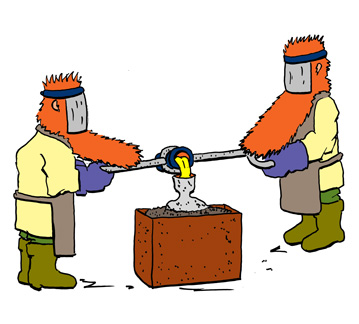
Did Rodin ever make his own bronzes?
OK, so we've got a plaster statue - quote - "made by Rodin" - unquote. What do you do with it?
In some ways, the plaster model is the original even more so than the clay model. It is the permanent record of what the sculptor wants. The artist - or his assistants - can also add details by carving, smooth out the rough areas, and to some degree make additions (there are some plaster models where Rodin himself added clay to indicate changes)
The plaster, we must emphasize, was primarily used as a reference for further work. If you wanted a marble statue you could work from the original clay model - and some of the carvers did - but in some cases a marble version wouldn't be carved for years. So you would use the plaster cast.
But most of all, the plaster models were used for making the bronze sculptures. And like the plaster model, the bronze is a cast.
There are two basic methods of bronze casting. Probably the most popular (particularly for small or medium size pieces) is the lost wax process (sometimes referred to by eggheads or French speakers as cire-perdue which means, of course, lost wax).
The primary sculpture for the lost wax method is, not surprisingly, a wax model. Now you can model in wax directly (as did Edgar Degas when making his "Little Dancer" sculpture) or Benvenuto Cellini in his Perseus with the Head of Medusa. However, for making a bronze statue, it is probably more common to use a wax cast.
Of course, to make a wax cast from the plaster, you need to make a mold. But what you don't want to do is destroy the plaster model. That is, as we said, the primary record for the artist. So you can't make a waste mold. Instead,a mold for making a wax statue has to be something you can put together and then take apart without destroying the plaster model.
Today wax casts are made using flexible molds which are almost always urethane or silicone rubber. But being flexible, they have to be held in shape by a rigid outer "mother mold" where the rubber inner mold fits in nice and snug. Then once you make your wax cast, you take apart the mother mold, and then peel away the rubber mold (also often made in separate parts). Today you can make lightweight mother molds from rigid plastics, but plaster is still popular since it's cheap and readily available.
So why a rubber mold? Well, with a well-made flexible mold you don't have to worry about the "undercuts" getting stuck in the mold and trapping the model where you have to destroy either the mold or the statue. But rubber molds only became practical after World War II. So what did Auguste use?
Now there were flexible molds in Auguste's time. These were made from gelatin products. But since they quickly dried out they couldn't be used to make multiple casts. So Auguste turned to the ubiquitous inexpensive material all artists had - plaster. But as we said, he couldn't make a waste molds.
Instead the molds for making wax casts were piece molds. That is, they were fashioned as pieces that fit into the mother mold like a 3-dimensional jigsaw puzzle. The pieces were designed to follow the lines of the undercuts and so could be lifted off without locking onto the statue. If this sounds complex, tedious, and requires experience and skill, it is. Some of these "piece molds" had over a hundred separate sections and had to be made by highly trained craftsmen.
For Auguste, it was again the Guioché's who made his best piece molds. As were their models, the molds were light and strong, and the father and son team made molds that reproduced the finest details. Like all master mold makers they took great pride in their work, reasoning (correctly) that without their skill, Auguste's studio wouldn't be knocking out the sculptures that would sell for over 100,000 francs.
Now most bronze statues are hollow. If the bronze is too thick, then when it cools the metal shrinks, and the surface will crack. Also bronze is heavy, and at some point, you have to move the statues around and set them up where you want. So the wax model also has to be hollow.
Now for a pleasant surprise. Hollow wax casts are actually pretty easy to make. One popular technique is by "slush" molding. You put the mold together (with the release agent inside, of course) and then pour in the wax. Then you slush it about and then pour the wax back out. You end up with a thin layer of wax coating the inside of the mold. Then as the leftover wax cools you pour it back in, slush it some more, and pour it back out. You repeat this until you get a uniform wax layer of about 3/16 of an inch. When the wax cools you can take it out of the mold. Obviously, you can make quite a mess, particularly if the mold leaks.
So we've got a wax cast. Now what do we do?
Well, obviously to make a bronze cast we need to have a mold that will hold up to the temperature of molten bronze. In the olden days of lost wax casting, the molds were made from clay and had to be super thick. But today a more convenient method is to dip the wax model into a colloidal silica suspension which contains wetting agents that will let it coat the wax. Then you take the wetted model and cover it in fine zircon sand. After this layer dries (for about three hours), you re-dip the model and re-roll it in the sand to make a second layer. You continue to dip and roll until you build up about ten silcia/sand layers. Due to technical reasons it's not a good idea to make more than three layers a day and the last layer should dry at least overnight.
Obviously for the method to be "lost wax" you have to lose the wax. This is done by heating the wax quickly (in a few minutes) to around 1600 degrees Fahrenheit. The wax melts and runs out of the mold and what remains inside burns out. The heating also helps harden the mold and you now have a hollow ceramic "shell" where you can pour your bronze. After the bronze cools you break off the shell and you have your statue. There are other details, of course, and you can see examples of mold making and bronze casting if you click here or here, or here and follow the appropriate links.
Now although Auguste preferred lost wax casting, the local Parisian foundries used sand casting. For sand casting, you pack sand into boxes which don't have a top or bottom, only sides. Naturally the sand has to be properly prepared - with the right amount of added water and binders - to hold its shape. Then once the sand is all properly packed, you press the model (or part of the model) into the sand and place another frame on top and pack in more sand. You can use the plaster model itself for the sand casting since you don't destroy the original.
So you end up with the object encased in sand. But since the sand is damp but firm, when you separate the two frames, the sculpture can be removed leaving the impress of the object in both frames. You can then reassemble the frames, and you have a positive mold of the object. Finally you make a channel in the sand, and pour in your bronze. Although it is hard to believe, a properly prepared sand mold holds its shape, and when the bronze cools the sand is easily removed (it is, after all, sand). So you've got your bronze statue.
Of course, you can see advantages and problems with sand casting. The main advantage is you can use the plaster model to make the mold. But since you are essentially making the mold from wet sand, a bump here or there can make the packed sand crumble and you have to repack it. You also usually have to cast the statue in pieces (common even in lost wax casting) and then put them together. Before World War II, the statues were usually assembled using rivets, but nowadays the statue is put together by welding. In fact, you can usually tell bronze statues made before and after the 1940's by whether it is riveted together or welded.
It's hard to say whether lost wax casting or sand casting is older. Lost wax casting goes back to around 4000 BCE, but tools were made by sand casting at the same time. The preference for sand casting in Auguste's time was probably because the industrial revolution required foundries to cast large parts quickly. Even working full time, with lost wax casting it can be three or four days before the final layer is added to the shell.
But a sand cast can be poured the day the foundry receives the model. Sand casting is faster, uses less and cheaper materials, and what materials it requires (particularly the sand) can be used again. The tricky part is making hollow statues. You have to make a "core" to take up most of the space inside the mold and still let the bronze form the cast. Positioning the core properly with bronze pins is touchy, and sand casting is not something the neophyte caster can do. Sand casts also come out with less detail than a lost wax statue, and it is likely that the "monumental" style of many of Rodin's statues were crafted with the idea they would be cast in sand.
To make the whole process bearable - and as cheap as possible - when Auguste wanted a bronze cast, he did what virtually all professional artists do today. He hired foundry time and just let the workers do their job. Few artists cast their own bronzes and the few exceptions are when the sculptors themselves work at or are owners of a foundry that also does casting for other artists as well.
Auguste's favorite foundry was the one owned by Alexis Rudier. Some authors have referred to the Rudier foundry as "Rodin's Foundry", but actually Alexis was an independent businessman and cast statues for other artists as well. After 1906, Alexis did all the casting for Rodin's studio.
Now just because Auguste and other artists let the professionals do the casting doesn't mean they aren't present during the casting or finishing of the statues. The 12 year old Jean-René Carrière, the son of the painter Eugène Carrière, went with his dad to watch the casting of a larger version of "The Thinker". This was by sand casting, and we hear it was cast as a single piece. Jean-René (who died in 1982 at age 94) was probably the last person alive to have seen Auguste in action.
L'Âge de Marbre
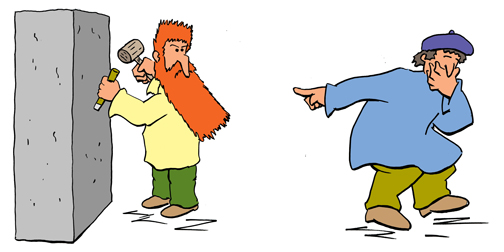
Auguste didn't understand the science.
Although we remember Auguste mostly for his bronzes, he made the lion's share of his income from selling marble statues. Now although there is one person who said she witnessed Auguste carving marble exquisitely, there is much more evidence that he rarely, if ever, wielded a chisel himself. Instead, he again resorted to the services of skilled practiciens, either on a per job basis or hired for a certain period of time as personal assistants.
You can see a problem beginning to raise its head. Marble carving is a highly skilled art and much of the admiration we have for marble sculpture is our appreciation of the manner in which the stone is actually worked. And we know that some of the marble artists that Rodin hired were so skilled that what came out had more of the carver - the practicien - than of Auguste - the modeleur.
An example of such collaboration is the marble portrait of Luisa Lynch de Morla Vicuña, the wife of the Chilean Ambassador. The practicien was Jean Escoula, then in his mid-thirties and an independent sculptor in his own right. Jean himself has a number of sculptures in the Musée d'Orsay (which also houses the statue of M. Morla Vicuña), and you see his works are put up for sale from time to time by art dealers. Of course, his independent works don't command the prices of a Rodin and which are pretty par for works you see even in some local art shows. The price of art, after all, is divided into two components, one being the cost of the art and the other the cost of the signature. A Rodin signature costs a lot.
When Auguste saw Jean's final statue, he wasn't satisfied. It wasn't that he didn't think it was a bad job. On the contrary he recognized it was an outstanding work. But there was too much of Jean's own artistry. He had paid Jean to copy what he, Auguste, had already done, not to make his own statue. And to tell the truth to tell, the portrait is not a typical Rodin. So although we have to give to Auguste credit for the design, at the same time we have to acknowledge that a good part of the statue's appeal is the way Jean carved the stone.
So who were the other practiciens that Rodin hired?
By far the most famous practicien was Camille Claudel who also was Auguste's girlfriend for about ten years (and if you believe some stories, the mother of two of his children). Camille, along with her English friend, Jesse Lipscomb, originally went to study (and occasionally have a smoke) at Auguste's studio. Camille actually liked stone carving, but she also did clay modeling, as did Jesse. Jesse returned to England after a couple of years, married, and raised a family, although she still continued to produce sculptures. Camille became a well known sculptor although her sad fate was to die in 1942 in a mental hospital in Nazi-occupied France.
Although Auguste sometimes made snide remarks about the type of art that was cranked out by graduates of the École des Beaux Artes, he certainly didn't care where the practiciens studied as long as they were good. One of the former Beaux Artes students was Antoine Bourdelle, and he worked for Auguste until 1905.
Charles Despiau was another sculptor who went to the Beaux Artes and was exhibiting in art shows when Rodin noticed his work. Rodin hired him as a rough-out artist and "pointer". He worked for Auguste from 1907 to when he was drafted into the French army in World War I. After the war, Charles kept working as an independent sculpture, never had assistants, and acquired quite a reputation.
Jean Turcan was a particularly skilled stone sculptor. He carved "The Kiss" that is in the Musée Rodin in the old Hotel Biron where Auguste had one of his studios. Jean was also an independent sculptor who produced a number of his own commissions for the government and ended up getting awarded the Légion d'honneur.
One of Auguste's most important practiciens was Henri Lebossé (a name Henri later upgraded to "Le Bossé"). Henri specialized in enlarging (or reducing) sculptures fashioned in clay or plaster. Henri would start his day's work by sharing a meal with Rodin, typically an omelet made with 10 to 15 eggs accompanied by four or five beefsteaks. This Falstaffian figure, one of the younger assistants remembered, had a personality between Tartarin and Gargantua. Henri himself claimed Rodin didn't understand the actual science behind making the sculptures. "Without me," Henry breezed, "Rodin would have gotten nowhere" and said flat out it was wrong for Auguste to take all the credit for his work.
Quand est un Rodin pas un Rodin?

Can we identify a "Real Rodin"?
Auguste's changing modus operandi eventually led to, if not controversy, then at least confusion. As demand for his work grew, he began to turn over more and more of the work to his assistants and workers. Eventually it got to the point that Auguste was limiting his own input to making the initial drawings, and the actual statues - from step 1 to le fin - were produced by his assistants and hired workers.
The young Russian sculptor, Yokov Nikoladze (also spelled Jakov Nicoladze) went to Rodin with a letter of introduction and asked to be taken on as an assistant. Rodin gave him a trial, not as a stone carver, but as a clay modeler. When Auguste saw what Yakov could do, he offered him a full time job, and Yakov worked for Auguste for a bit more than a year.
Once Auguste gave Yakov the assignment to work on a memorial mostly using photographs (yes, a number of famous artists, including Paul Gauguin, Thomas Eakins, and Norman Rockwell, sometimes worked from photographs). Yakov remembered that Auguste would come in, look at what he did, say "Pas mal!" ["Not bad!"], and walk off. Then when Yakov thought he was done, Auguste would come in, look the statue over, and then suggest so many changes that Yakov would have to start all over again. He'd get that version done and then Auguste would bring in more photographs of the subject. So Yakov would start over again. This would go on for months.
But finally at some point Auguste would decide that Yakov had done all he could do. Now he, Auguste, would take over. So Yakov would go home. But when he got back to the studio, he'd find Auguste had done nothing more than make some marks along the shoulders. Then, of course, the statue went to the plasterers, mold makers, and then to the foundry or marble carver where it was sold as an original Rodin. A "Rodin" that Rodin had hardly touched!
OK. So when is a Rodin a Rodin? Or equally important, when is a Rodin not a Rodin.
Perhaps the best way (that's perhaps the best way) to answer the question is to look at two extremes.
First, if we have a clay sculpture that Rodin himself fashioned with his own hands, then we have a real Rodin.
But today if Joe Blow (or his sister Josephine) make their own copy of the Thinker - even if crafted using an original as the model, then this is indisputably not a real Rodin. It is a reproduction. It may be a good reproduction, but it isn't authentic and definitely not a Real Rodin.
But the consider this. If Auguste asked Joe or Josephine to make a copy from one of his original, particularly in marble, then it would be an original Rodin. It may not even be a good statue, but it would be a Real Rodin.
But at this point the discerning reader will immediately see the infinite shades that are available in the continuum of Real Rodinism.
- Rodin may have done all of the sculpting with his own hands.
- Rodin may have done most of the sculpting with his own hands and an assistant or hired worker helped a bit.
- An assistant may have done everything with only a few touches by Auguste.
- An assistant may have done everything but under Auguste's supervision.
- An assistant may have done everything and not under Auguste's supervision but with his "authorization" (whatever that means).
- A number of people may have worked on the statue with input from Auguste that runs the gamut from Steps 1 - 5.
Now these six categories can apply to all of Rodin's sculptures regardless of media. For instance, we have clay sculptures made by Auguste himself or sculptures that Auguste assigned to hired workers like Yakov. Then he may have had the Guiochés make a plaster model who passed it on to Camille or Jean to carve into marble. Then of course, there are some cases where a bronze cast was made when Auguste was actually present and others where he may have stayed home.
OK. So when is a Rodin a Rodin?
Too bad we can't ask Auguste himself.
But wait! Amboise Vollard, the famous art dealer (who represented Pablo Picasso) did ask Auguste. So even when Auguste was alive people were wondering how can you actually say something was an original Rodin if Rodin may have done virtually nothing. Auguste blithely replied,
"It's quite simple. A true Rodin is one that has been cast with my consent. The false is done without my knowledge."
Simple, non?
Well, non. Ce n'est pas simple.
And we have no one to blame but Auguste himself.
For one thing, Auguste doesn't say anything about him actually making anything or even supervising the work. As long as the sculpture is made with his knowledge and consent, then hey, presto!, you've got a Real Rodin.
Ah, c'est simple!
Non, ce n'est pas simple.
It's clear that Auguste's modus for making a Real Rodin marble was to have the actual carving done by a hired practicien. But the practicien had to carve using a model that Auguste either made himself or personally approved. So at least a Real Rodin has to be carved in his own lifetime.
Ah, c'est simple!
Non, ce n'est pas simple.
Now the "Made in Auguste's Lifetime" criteria works for the marble statues. But Rodin also made bronzes. And here is where things get really sticky.
Auguste bequeathed his plaster models and molds to the French government knowing that more "Rodins" were going to be made. So what about a bronze that is cast after Auguste passed to the great Hotel Biron in the sky?
Well, they are certainly made with his consent since he gave the government his molds or models. And he had knowledge the government would be making more Rodins. So by Auguste's definition, aren't these Real Rodins.
Ah, oui! C'est simple!
Non, ce n'est pas simple.
If you turn to Auguste's will, we read that he gave the French government the molds and models for - and pardon us if we shout - DROITS DE REPRODUCTION - that is, the RIGHTS OF REPRODUCTION of his statues. He did not give them DROITS DE FAIRE PLUS DE STATUES ORIGINALES. So again if we go by what Auguste wrote shouldn't we call anything after Auguste died a reproduction?
Ah, oui! C'est simple!
Non, ce n'est pas simple.
Consider this. The plaster models are not the finished works. They are intermediate stages on the way. So if a final bronze wasn't made before Rodin died, wouldn't he have wanted someone to finish job?
In some ways the cumulative work of Rodin's career was the massive La Porte de l'Enfer. He started work on it in 1880, but for various reasons - among them that Rodin kept dawdling - it was never cast during his lifetime.
But a few years after Auguste died, the Philadelphia millionaire and theater magnate Jules Mastbaum decided he'd like a Rodin. So he paid for the casting of the Gates. As this was the first casting and (presumably) made from the plaster models from Rodin's own studio, he was indeed completing what Auguste never finished. So Jules felt justified in saying he had a Real Rodin.
By casting the Gates, Jules established the precedence years that if a bronze was cast from the original plaster models, they were Real Rodins. It is, of course, considered proper to note the date of the casting. That way everything is on the up and up.
Ah, c'est simple!
Non, ce n'est pas simple.
One wee little problem with this approach is you can now have a never ending supply of Real Rodins. So eventually the French government passed a law that states that after you make 12 casts (four artist's proofs and eight duly numbered "originals"), then anything else has to be designated a reproductions and labeled as such.
Ah, c'est simple!
Non, ce n'est pas simple.
Note that this 4 + 8 = 12 criterion is a recent innovation and this stipulation was not, repeat not made with Rodin's knowledge and consent. When he was alive he sold over 300 small (mostly marble) versions of "The Kiss" (and, we must point out, made a nice bit of change). All of these are Real Rodins as they were made with Auguste's knowledge and consent.
So all Real Rodins, then, must be made using his original plasters or molds, non?
Well, non. Even when he was alive Rodin did not always have the foundries use his original models. Making molds can be a bit tough on the models, and even sand casting abrades the surface of a plaster model. So instead of risking his original model, Auguste would often make another copy and that was sent to the foundry. But he - that is, Auguste - still considered the cast to be a a real Rodin. It was, after all and as we wearily keep pointing out, made with his knowledge and consent.
Today the original plasters are not used any more since they are considered too valuable. So instead the bronze casts are made from copies, but copies which are produced from the original plaster's and molds. Now some places opt for caution and if you see a Rodin that has been cast in more recent times, such as Burghers of Calais which was cast in 1985, the brochures will state it was made from the plasters from the French government, but make no claim that the plasters were Auguste's originals. So as long as a statue is at least, shall we call it, a lineal descendant from one of Auguste's original models or a direct copy from the originals that were themselves made with Auguste's consent and knowledge, can't we say we have a Real Rodin?
Ah, oui! Maintenant c'est simple!
Non. Il ne sera jamais simple.
We saw that Auguste would sometimes take one of his finished marble statues and then have a mold made. Then the Guiochés would make a plaster model and ship it to the foundry. Once more Auguste considered that bronze to be a Real Rodin.
But suppose we go today to Grawemeyer Hall at the University of Louisville and (with permission of course) make a modern urethane or silicone mold of the Thinker that's sitting outside the building. This statue was cast in 1905 and fully with Auguste's approval and supervision. In fact, this was the first cast of the large version of the Thinker and so is not only a real Rodin but the original bronze cast to boot. If we were to take our molds and make a new bronze, it would look as good as the original. But it's questionable whether that should be called a real "Real Rodin".
Now to make things even more complicated, consider this:
With laser imaging technology we can directly carve marbles or make fused bronzes from a model. So we could make marbles and bronzes directly from Rodin's original plaster models as this 3D printing would cause no damage or wear to the models. The new statues would even be "closer" to Auguste's original than a marble or bronze made using the traditional carving and casting methods. So shouldn't these new statues be a "Real" Rodin?
A Modest Proposal
With all the questions, nuances, and brouhaha confounding the issue, we offer a Modest CooperToons proposal. Rather than making any kind of "yes/no" designation of whether a statue is a Real Rodin, we will assess every "Rodin" for it's "Rodin Realness" as a quantitative percentage . And to make sure we appeal to the masses and not just the intelligentsia, we will stick with middle school math.
So when we say a statue is a such-and-such percentage "Real Rodin" we will use the simple equation:
% "Real Rodin" = 100 × (1-[Year-1917] ÷ Year)(10 × Distance)
Some minor explanation may be needed. Here the "Year" is the year the actual version was cast. But you use the number 1917 if the statue is made in 1917 or earlier. Otherwise you use the actual year of the casting.
Now the "Distance" variable refers to how "close" the model is to either Rodin's original or a model made with Auguste's personal approval. For instance, if the foundry used an original model made by Rodin himself or under his approval, the distance is "0". But if a copy used in the casting was itself made from the original but after Auguste was no longer around, then the distance is "1". If a copy is made from that copy, then distance is "2" and so on. On the other hand - an important point - if the model is not in any way made directly from one of Auguste's original - such as Joe or Josephine making their own model from scratch - the distance is infinite. In that case the % Real Rodin would be zero.
So what, to paraphrase Flakey Foont, what does it all mean?
First notice that any bronze cast made during or before 1917 is a 100% "Real" Rodin, no matter how many plaster sequential copies were made. All we require is Rodin had knowledge and consent for making the models.
% "Real Rodin" = 100 × (1-[1917-1917] ÷ 1917)(10 × 0) = 100 %
% "Real Rodin" = 100 × (1-[1917-1917] ÷ 1917)(10 × 1) = 100 %
% "Real Rodin" = 100 × (1-[1917-1917] ÷ 1917)(10 × 1000000) = 100 %
OK. Now for other cases.
Let's say we go to a museum and see a "Rodin" cast in 1925 (Year = 1925). But say the French government sent the foundry, not Rodin's plaster model, but a copy made made directly from the original. So Distance = 1. Putting in the numbers we get:
% "Real Rodin" = 100 × (1-[1925-1917] ÷ 1925)(10 × 1) = 96 %
Well, that's OK. That's certainly pretty good. Many people would be happy with a 96 % Real Rodin.
But suppose in 1985 someone in Cookietown, Oklahoma wanted to buy the same statue. But to save shipping costs they want the casting done locally (there's plenty of sand a short distance off on the Red River). Of course, the 1925 plaster is considered too valuable to ship overseas. So we will make a new one from the 1925 plaster, and send the copy. This will count as an additional step in the sequence. So Distance = 2. Then with the Year = 1985 and a Distance = 2, our % Real Rodin is:
% "Real Rodin" = 100 × (1-[1985-1917] ÷ 1985)(10 × 2) = 50 %
Now suppose in 2014 someone goes to the University of Louisville and makes the rubber mold of the U of L Thinker. Now the cast itself was made in 1905, and so this is a 100 % Real Rodin, no matter what. But regardless of the % Realness of the bronze statue, if we make a mold, the bronze is now doing duty as a cast of the approved foundry model. But since Rodin did not intend it to be used as a copy, we must assign it at least a Distance = 1. But we now take the mold and make another plaster model that will be used in the sand casting. So we have to assign Distance = 2. So with "Year = 2014" and "Distance = 2", we get:
% "Real Rodin" = 100 × (1-[2014-1917] ÷ 2014)(10 × 2) = 37 %
So even if you make a copy of a finished 100 % Rodin, the percent "Realness" drops pretty quickly.
But what about our laser copies made from Auguste's original? Well, here we need to modify our equation. We say that a copy is made using laser technology - or any technology created post-Auguste - then our % Real Rodin is given by:
% "Real Rodin" = 100 × (1-[Year-1917] ÷ Year)(100*Year ÷ 1917)
So if we make a 3D copy in 2014, even from Auguste's original
% "Real Rodin" = 100 × (1-[2014-1917] ÷ 2014)(100*2014 ÷ 1917) = 0.6%
Hardly a Real Rodin at all!
The author of CooperToons realizes this Modest Proposal is by no means the final word. But it is without doubt the first major step forward for the resolution of one of the most perplexing questions which has bedeviled the art community, nay, even the world, since November 17, 1917.
References
Rodin: A Biography, Frederic Grunfeld, Henry Holt, 1987. A chapter of the doings in Studio Rodin and a lot about his helpers.
Rodin: The Shape of Genius, Ruth Butler, Yale University Press (1996). Also information on Rodin's student's, assistants, and collaborators.
Camille Claudel: A Life, Odile Ayral-Clause, Abrams (2002). The biography of Rodin's student, assistant, and girl friend who is recognized - a bit belatedly - as a major sculptor in her own right.
Rodin-Web, www.rodin-web.org/. A website about Rodin and his sculptures. However, it appears not to be currently being maintained and the paths to a number of the pages are not easily reachable from the home page.
Rodin's Art: The Rodin Collection of Iris and B. Gerald Cantor Center of Visual Arts at Stanford University, Rosalyn Frankel Jamison and Albert E. Elsen, Oxford University Press, 2003
Rodin a l'Hotel de Biron et a Meudon, Gustave Coquiot, Librairie Ollendorff, 1917. An appendix has Auguste's rather lengthy bequest to the French government en français.